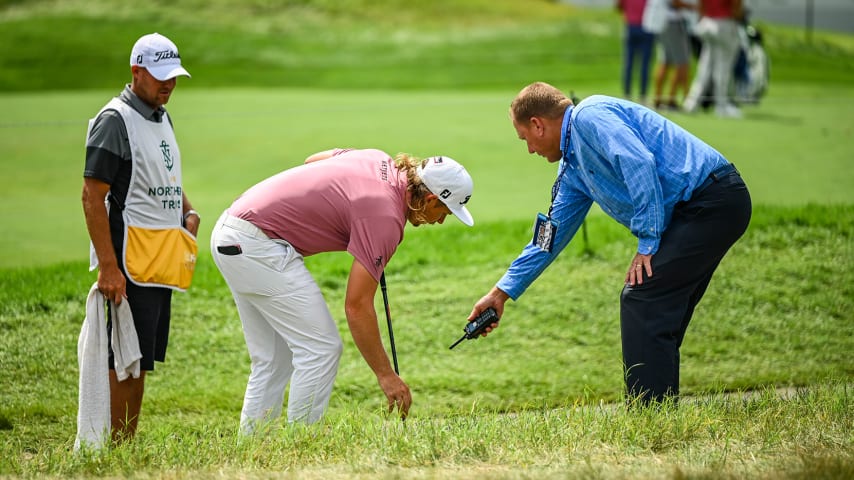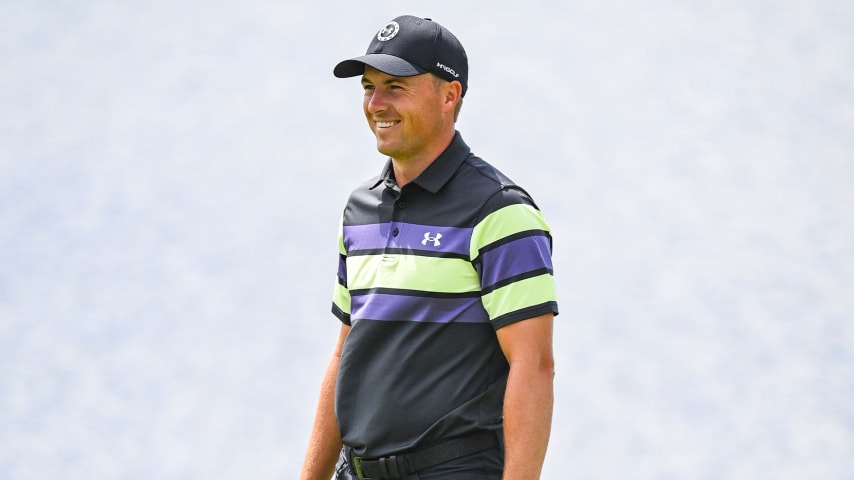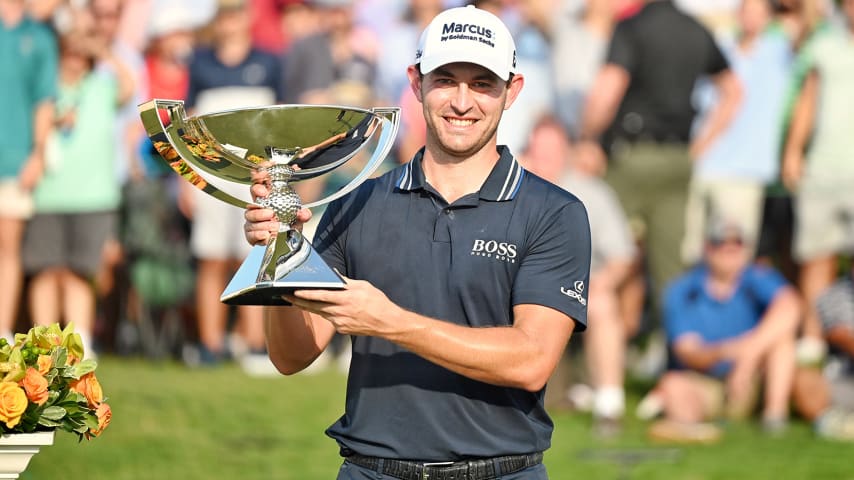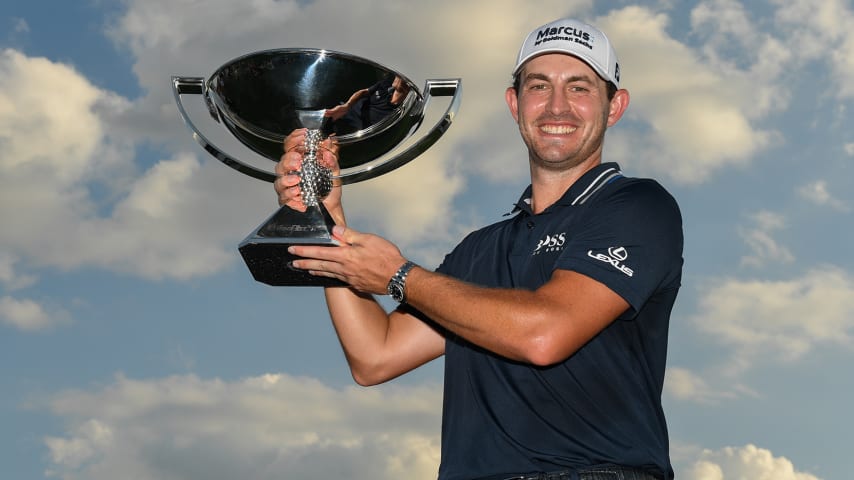Reliving some of 2021’s high-profile rulings
10 Min Read

From Bryson DeChambeau to Patrick Reed, let’s revisit these incidents to deepen our understanding of the Rules of Golf
Written by Mark Dusbabek,
From Bryson DeChambeau to Patrick Reed, let’s revisit these incidents to deepen our understanding of the Rules of Golf
Rules officials enforce the laws of the game at every PGA TOUR event. The rulings they hand out can range from the mundane to the truly bizarre. While the countless cart-path drops each week can start to run together, there are some unique situations that are truly memorable. We had several of those this year. Before we close the book on the 2021 PGA TOUR season, let’s revisit some of the rulings that sparked plenty of discussion among golf fans.
By highlighting these rulings, I hope to bring more awareness to the process our officials undertook to properly enforce the Rules of Golf.
1. TO OB OR NOT OB
This situation occurred during the final round of the World Golf Championships-FedEx St. Jude Invitational, after Bryson DeChambeau’s tee shot on the par-4 sixth hole came to rest under the meshed fencing that defined the out-of-bounds on the hole’s right-hand side. With DeChambeau in the final group alongside Harris English, this was a crucial ruling that received plenty of airtime and incited its fair share of debate.
The immediate inclination of many watching was that the ball was indeed out of bounds. In reality, it was still in play.
Let’s explain.
For a ball to be ruled out of bounds, the entire ball must lie beyond the boundary line of the course. This imaginary line runs at ground level on the course-side edge between the two boundary stakes on either side of DeChambeau’s ball.
The referee on site correctly laid a string between the two stakes and found that a small portion of DeChambeau’s ball intersected with the string. Thus, the ball was ruled to be in-bounds.
Since the ball was determined to be lying in-bounds, it was now up to DeChambeau to determine how he would like to proceed. Because this fence was a boundary fence, relief was not an option. Would he try to play the ball lying under the mesh fence or would he take an unplayable lie?
A cart path situated adjacent to the OB fence added another wrinkle to this ruling. DeChambeau would be standing on the cart path if he tried to play his ball from under the fence. A player is entitled free relief from a cart path, unless, under 16.1 (3), the shot “would be clearly unreasonable because of something other than the immovable obstruction because of where the ball lies.” The immovable obstruction, in this example, was the cart path. DeChambeau would not be given relief from the cart path if a rules official determined it was unreasonable for him to play his ball from under the fence.
That’s why the rules official asked DeChambeau, “If the cart path wasn’t here, how would you play your ball?” Without hesitation, DeChambeau explained that he would punch his ball from underneath the fence back into the fairway. Attempting to play this shot, he would have to stand on the cart path.
Since the shot described was reasonable, DeChambeau was granted free relief from the cart path and was able to use the Rules of Golf to his advantage.
2. PLUG LIFE
Southern California is known for its sunshine, but bad weather can be an issue when the TOUR visits in the winter month. This year’s Farmers Insurance Open was no exception, as the scenic South Course at Torrey Pines was closed because of high winds Monday and hit by hail in the second round. With the ground saturated by rainfall, embedded balls became one of the storylines over the final two rounds.
It started Saturday, after Patrick Reed pulled his approach shot on the par-4 10th hole into deep rough left of the green. The ball landed outside of Reed’s field of vision. That is an important detail in this ruling.
Prior to arriving at his ball, Reed asked a volunteer if she saw his ball bounce. The volunteer did not see the ball bounce after it landed in the rough. Based on the volunteer’s assessment, and the fact that the turf was soggy, Reed wanted to check to see if his ball was embedded in the ground. Reed informed his playing partners that he was checking his lie and called for a referee’s assistance to provide the final determination.
Under the Rules of Golf, Reed correctly marked and lifted his golf ball to determine if it was indeed embedded. When the referee arrived, he inspected the pitch mark caused by Reed’s ball and confirmed that the ball was embedded and free relief was available.
Due to the wet conditions at Torrey Pines, McIlroy had almost the exact same situation occur on the 18th hole. He believed his ball was embedded in its own pitch mark and correctly marked and lifted his golf ball to determine if the ball had indeed embedded. McIlroy confirmed that it was embedded and was also able to take free relief.
In these two situations, one player acted with the help of a referee and the other acted on his own. Both situations are allowed and both players are viewed under the Rules of Golf, to have proceeded correctly.
3. ARBOR DAY
During this year’s Arnold Palmer Invitational presented by Mastercard, Jason Day’s tee shot sailed toward the trees right of the fairway on Bay Hill’s 16th hole. Day’s ball was heard rattling around the trees. No one saw it fall to the ground, however.
Upon reaching the area where his ball was likely to be, a search by the volunteers, spectators and the players and caddies in the group began.
In 2019, the time allotted for a player to search for his ball was reduced from five to three minutes. The clock starts when the player or his caddie begins to search.
If the ball is not found and identified before the three-minute window expires, the player must return to the site of his last shot under a stroke-and-distance penalty. In this case, Day would have to go back to the tee and play his third stroke.
If “a” ball is found in the tree, it must be identified by the player as his ball. Simply finding a ball with the same brand and number do not automatically make that specific ball the player’s. The specific markings on the ball the player used to signify that it was his ball, need to be seen.
If the player can identify the ball as his, he can declare it unplayable proceed under the rules for an unplayable lie. This would allow Day, under the penalty of one stroke, to drop a new ball within a club length of the spot on the ground directly beneath where his ball sat in the tree. This option is much less severe than going back to the tee.
As the 3-minute search wound down, someone spotted a ball high up in the tree. Not knowing if it was his ball, Day had various means to try and identify the ball as his.
He could climb the tree, throw something at the ball to dislodge it or use a rangefinder or binoculars to identify it. Unfortunately, the ball was too high in the tree for any of these options to work.
Just prior to Day’s three-minute window expiring, a photographer was spotted in the crowd with a very large zoom lens attached to his camera. Per the referee’s request, the photographer snapped a photo of the ball in the tree and was able to enhance the still image to check the markings on the golf ball.
This allowed Day to identify the ball just as time expiredwas able to proceed under his unplayable options. This was an extremely fortunate result due to the nearby photographer.
The same issue arose for MacKenzie Hughes on the par-3 11th hole in the final round of the U.S. Open at Torrey Pines.
4. BUBBA’S BUSTED DRIVER
Bubba Watson’s massive clubhead speed has been an asset throughout his PGA TOUR career, helping him to 12 PGA TOUR victories, including two Masters. But his driver couldn’t handle it anymore in the second round of this year’s Travelers Championship.
The head of his driver snapped off the shaft as Watson took one of his mighty swings on the second tee at TPC River Highlands. Because Watson had made a stroke at his golf ball, it was counted as a shot. Fortunately for him, the ball traveled down the center of the fairway.
Because the club was broken in the normal course of play, Watson was able to replace his driver (as long as play was not delayed). He immediately requested a referee to see if it was possible to put the same clubhead on a shaft that was in his car.
This was a very unusual, and confusing, ruling. The PGA TOUR utilizes Model Local Rule G-9 for this specific reason. The rules state that “if a player’s club is broken or significantly damaged during the round by the player or caddie, except in cases of abuse, the player may replace the club with any club.”
Therefore, Watson was allowed to replace his driver with any club he chooses.
Watson’s request to assemble a new shaft into the existing driver head created a separate situation. A player is not allowed to assemble a club during play with other components. However, the rule specifies that a club cannot be assembled from components carried on the course by or for the player. Since the driver shaft was in his car, the driver could be assembled at his car and then brought to him. But Watson opted, instead to replace the broken club with a driver that had already been assembled. That club was retrieved from his car for him to use for the remainder of the round.
5. RUSSELL’S ROLL
Russell Knox started the final round of this year’s AT&T Pebble Beach Pro-Am in second place, just two shots off the lead. Having a rules situation on the opening hole is not the way any player wants to start a Sunday in contention, but Knox needed a ruling before striking his second shot of the day.
Knox’s ball moved prior to him beginning his swing, after he addressed the ball by placing his club just behind the ball. Knox immediately recognized that his golf ball had moved and correctly asked for a referee’s assistance.
If a player’s ball at rest moves (i.e. comes to rest in a different location), he is not penalized if natural forces caused the ball to move. He would then play the ball from its new position. He is subject to a one-stroke penalty if he caused the ball to move, however.
How do we know if the player caused the ball to move? The determining factors are made by speaking to the player and reviewing the actions the player took prior to the ball moving. The timing of these actions relative to when the ball moved are factored into the final determination.
For example, did the player make a practice stroke next to the ball and the ball immediately move? Or perhaps the player lightly grounded his club and the ball moved after he did so. If this was the case, how long after he had set his club down behind the ball did the ball move? One or two seconds? Five seconds? Ten seconds? How soon after these actions does the ball have to move for the player to be penalized?
The referee handling the ruling asked Knox to show him the actions he took and how much time he thought elapsed before the ball subsequently moved. The player believed that the ball had moved a few seconds after his actions and felt nothing in his actions could have caused the ball to move.
Because of the pressure PGA TOUR players are constantly under, it can sometimes be challenging to recall an incident in real time. Everything has slowed down in their minds and their focus of hitting a perfect shot and winning a golf tournament is all that they are fixated on.
Upon hearing the description from Knox, the referee explained there would be no penalty and the player should play his ball from its new location.
Shortly after the ruling, a video clip of the ruling was presented to the PGA TOUR’s Rules Committee. After reviewing the replay, it was clear the ball moved immediately after the player grounded his club behind the ball. The player should have been penalized for moving his ball at rest.
As a result, a one-stroke penalty was later added to Knox’s score for the second hole and the player was informed by the rules committee as soon as possible on the golf course.





